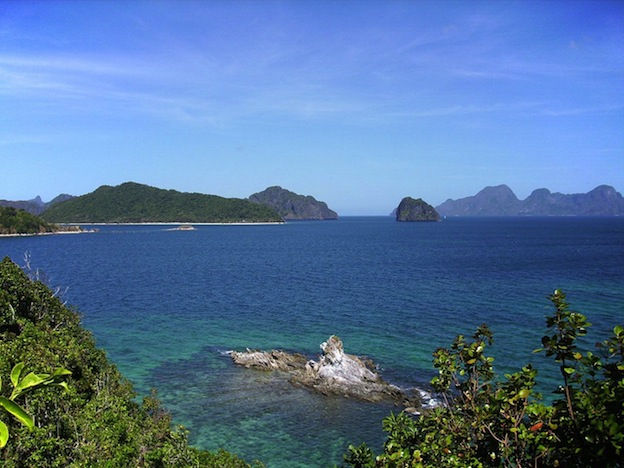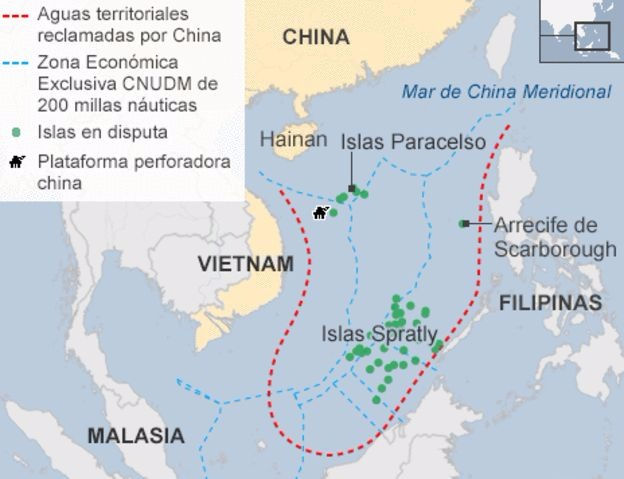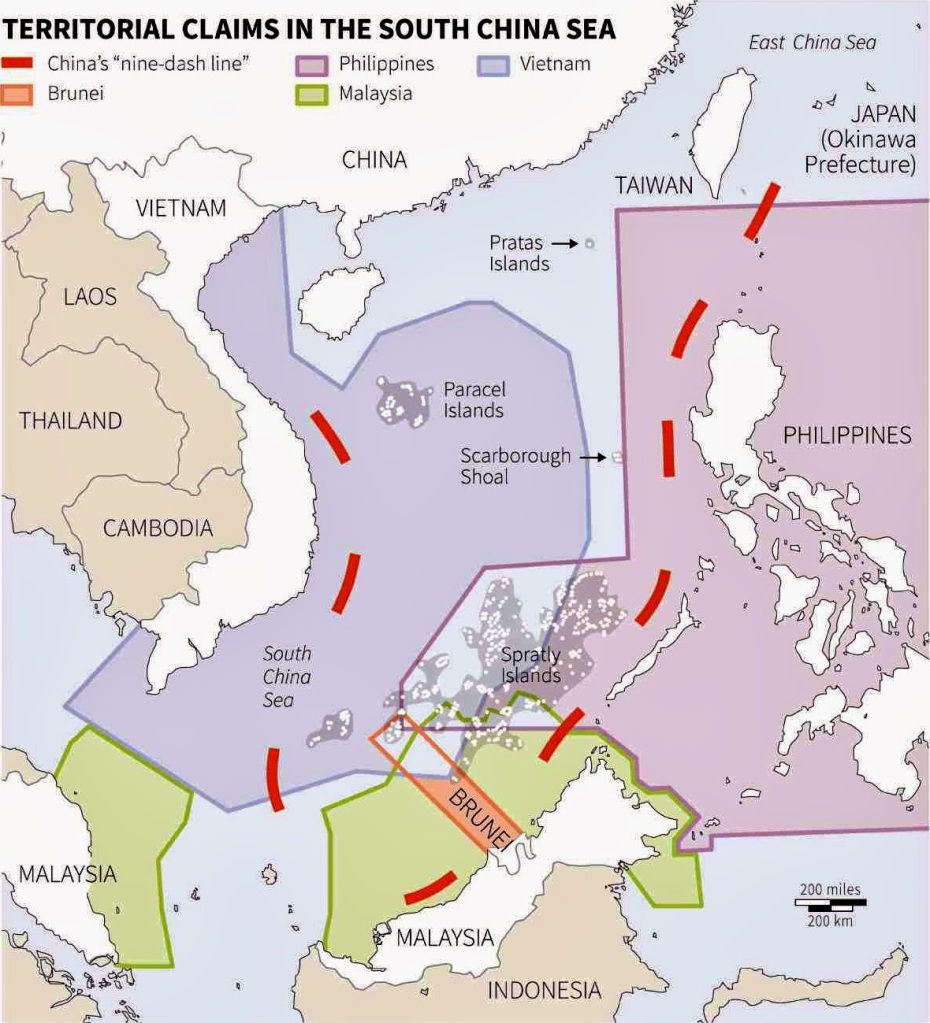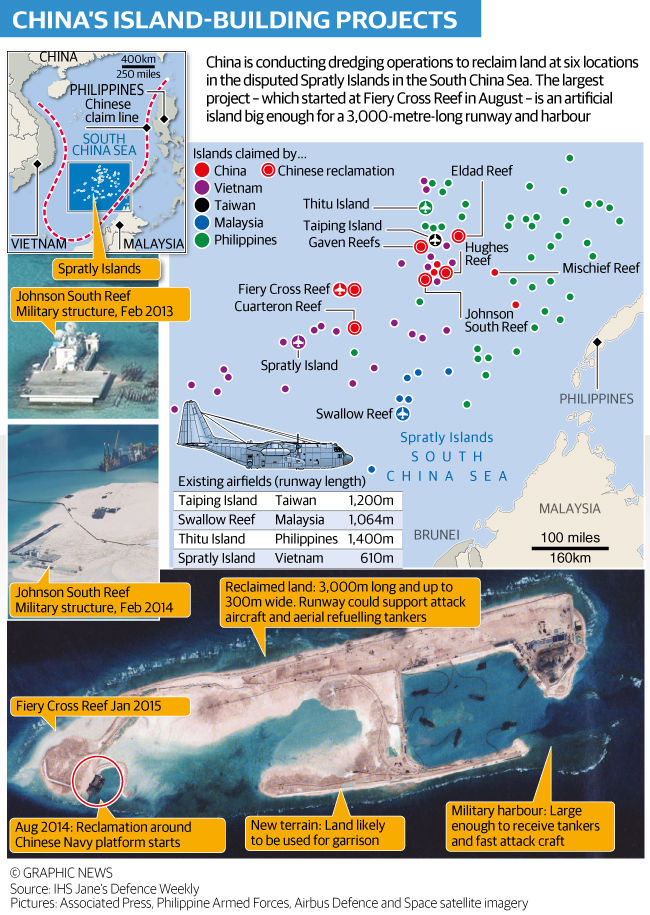The ocean has played a fundamental role throughout history. The expansions of the great world powers were based on maritime expansion, the search for new resources, the establishment of zones of influence and economic, political and military gains. Since the end of the 20th century and the beginning of the 21st century, the Pacific area has regained its weight and shifted the axes of trade, energy and power.

The South China Sea is the region where the greatest economic, military and political growth in international affairs is concentrated. This region of the world covers 3,500,000 km2, connected to the Indian Ocean through the Straits of Malacca, Lombok and Sunda. Of these straits, the Malacca Strait is vital for the transport of goods from Africa and the Middle East to China, Japan, Taiwan and Korea, as more than half of the world's merchant tonnage passes through this region.
In this sea there are more than 200 islands, islets, rocks, reefs, where the vast majority are located in the archipelagos of the Spratly Islands and the Paracelsus Islands. These islands and islets are mostly uninhabited, but are the key to gain more influence in the region, and for the increase of the respective exclusive economic zones, which would allow these countries the free extraction of resources that are supposedly found in the soil and subsoil of the sea, where China and the U.S. are fighting for control of this vital region. This article aims to shed light on this sensitive and, at the same time, key issue.
Before addressing the historical question, it is important to highlight several important facts. The South China Sea is a shallow body of water bordered by the Philippines, Taiwan, Malaysia, Singapore, Indonesia, Thailand, Brunei, Cambodia and Vietnam. To the northeast is the Taiwan Strait, to the east is the Malay Peninsula and to the south is Borneo.
This great elliptical-shaped central basin body of water contains more than 250 small islands, atolls, shoals, reefs and cays. Its islands are not inhabited, but during the last few years, military bases have been built. In this sea there are 4 major groups of islands are the most important: Spratly Islands, Macclesfield Islands, Paracelsus Islands and Pratas Islands.

Map 1: Chinese claims and description of the South China Sea. Source: http://jomros.blogspot.com/2017/04/conflictos-en-el-mar-de-china-meridional.html
In addition, this sea is very rich in natural resources. It has reserves of natural gas that may constitute the largest hydrocarbon resource in the entire region and abundant fishery resources of the first magnitude, essential for food in Asia. In addition, its waters are an important maritime route that has been navigated for many centuries.
Throughout the first half of the 20th century, this sea remained out of the spotlight as neighboring and riparian states focused their attention on conflicts elsewhere.
At the end of World War II (1939-1945), Japan relinquished these two large archipelagos, and neither state occupied a single island in the entire South China Sea.
In 1946, China began to establish a foothold in some parts of the Spratly Islands and, the following year, took control of Woody Island, part of the Paracel Islands, two weeks before France and, later, Vietnam landed on these islands. This led Paris and then Hanoi to focus on the Pattle Islands.
During this time, the South China Sea was not a priority for any of the claimants. Thus, after suffering their catastrophic defeat at the hands of Mao's communists, Chiang Kai-shek's forces withdrew to Taiwan and abandoned their positions in the South China Sea, and neither France nor Vietnam seized the opportunity.
The tables would turn from the 1950s onwards. In 1955 and 1956, China and Taiwan established permanent presences on several islands, while the Philippines claimed a large part of the Spratly Island chain as its own.
In the early 1970s, the dispute would escalate over indications of oil deposits under the waters of the South China Sea.
The Philippines was the first to act and China conducted a cautious and coordinated invasion of several islands. In the Battle of the Paracelsus Islands (1974), Beijing wrested several of them from South Vietnamese control, killing several dozen Vietnamese and sinking a corvette in the process. In response, both South and North Vietnam reinforced their remaining garrisons and seized other unoccupied elements.
In 1982, the United Nations Convention on the Law of the Sea (UNCLOS) was signed and ratified by a number of states, granting countries sovereignty over waters that are no more than 200 miles from their coasts. The rest are considered international waters, where ships can navigate freely.
After the Battle of the Paracelsus Islands, the waters would return to normal, with incidents in 1988 and 1995. In the late 1980s, Beijing pushed into the Spratly Islands and, forcibly seized Johnson Reef, killing several dozen Vietnamese sailors in the process. In 1995, Beijing decided to build bunkers on Mischief Reef following a Philippine oil concession.
In 2002, this tension led to the signing of the Declaration on the Conduct of Parties in the South China Sea between ASEAN member states and the People's Republic of China.
This statement was intended to establish a framework for the eventual negotiation of a Code of Conduct for the South China Sea. The parties involved agreed to "exercise self-restraint in conducting activities that could complicate or escalate disputes and affect peace and stability, including, among others, refraining from habitation actions on currently uninhabited islands, reefs, shoals, cays and other features, and to deal with their differences in a constructive manner."
For years, this declaration settled tensions until 2009. In May 2009, Malaysia and Vietnam sent a joint submission to the Commission on the Limits of the Continental Shelf outlining their claims.
The rest of the players did not hesitate to respond to this letter and, specifically, Beijing responded to this statement by presenting a map with "the nine-dashed line".

Map 2: Territorial claims in the South China Sea. Source: https://mackenzieinstitute.com/threat-posed-chinas-reclamation-initiatives-implication-2015-chinese-defense-strategy/
This line meanders around the edges of the South China Sea and encompasses all the territorial features of the Sea, as well as the vast majority of its waters. Beijing has maintained "strategic ambiguity" and has only said that "China has indisputable sovereignty over the South China Sea islands and adjacent waters, and enjoys sovereign rights and jurisdiction over the relevant waters, as well as the seabed and subsoil therein.
The region is increasingly concerned about China's interests and actions in the South China Sea. Consequently other actors have also set and moved their cards in this region of the world.
During 2010, China and Japan were engaged in a territorial dispute. As a result, Beijing banned the supply of rare earths, necessary for the Japanese electronics industry, to Japan.
Tensions were settled, but the signal was sent that Beijing could block Japanese trade, which would have to be diverted elsewhere at considerable cost. In fact, control of the South China Sea would allow China to interfere with Japanese and South Korean trade through the area. Thus, the U.S. would show a greater interest in the region.
In 2010, during a meeting on Asian security, former U.S. Secretary of State Hillary Clinton declared that the peaceful resolution of territorial disputes over the South China Sea is in the "national interest" of the United States.
Clinton told the meeting participants that the United States had "a national interest in freedom of navigation, open access to Asia's maritime commons, and respect for international law in the South China Sea."
A year later, the Obama Administration guaranteed that the presence and missions in the Asia-Pacific scenario would become one of its key priorities and that spending dedicated to this scenario would not be affected by any cuts.
Since 2012, the Chinese Communist Party included the archipelagos among its "core national interests" by increasing sea dredging, sending troops and developing a project to build an airport.

Map 3: China's island construction projects. Source: https://warnewsupdates.blogspot.com/2015/05/more-signs-that-chinas-artificial.html
In the same year, Beijing seized the Scarborough Shoal from the Philippines. The two states had been at loggerheads over allegations of illegal fishing by Chinese fishermen. After two months of confrontation, the parties agreed to withdraw from Scarborough Shoal. Manila did so, but Beijing did not.
In response, in 2013, Manila filed a legal recourse to the United Nations Convention on the Law of the Sea, Vietnam supported this recourse filed by Manila.
The Philippines focused its claims on maritime law issues and, Beijing argued that they cannot be resolved without first deciding the territorial issues. For this reason, Beijing has largely refused to participate in the process.
In May 2014, Beijing tried to take another step further. A Chinese state-owned oil company moved one of its platforms into waters claimed by Vietnam south of the Paracel Islands. This provocation led to clashes between Vietnamese and Chinese vessels around the platform, as well as riots against foreign-owned companies in parts of Vietnam. Faced with this reaction, China withdrew the platform in mid-July 2014.
The following year, Beijing accelerated its land reclamation campaign in the South China Sea. In at least seven locations, Chinese vessels have dumped tons of sand to expand the size of the areas occupied by China. Beijing has also begun construction of infrastructure on much of this reclaimed land, including an airstrip capable of receiving military aircraft.
In response, in October 2015, Washington responded to Beijing's actions by launching "freedom of navigation" naval patrols in the South China Sea, sending the signal that the US would not be expelled from the region.
In 2016, an arbitral tribunal in The Hague issued the verdict on the Republic of the Philippines v. People's Republic of China case. In the judgment, the tribunal upheld the rights of the ASEAN claimants over their Special Economic Zone, clarifying that the Chinese claim had no legal basis.
Beijing ignored the legality in this dispute and over time, military power has gained greater weight to back up the PRC's maritime claims.
Another actor that did not lose sight of this dispute was Taiwan. The Republic of China (popularly known as Taiwan) shares many of its claims with the People's Republic of China, due to the course of the Chinese Civil War.
Taiwan is not a member of the United Nations, is not a party to the UN Convention on the Law of the Sea (UNCLOS) and a request by Taipei to send an observer delegation to the hearings was denied.
In this case, the Hague tribunal addressed the issue of the status of Itu Aba, known as Taiping Island in Taiwan. This island is the largest natural feature of the Spratlys group, occupied by Taiwan and is home to a military garrison, a hospital and a farm.
The Hague tribunal found that Itu Aba along with the rest of the Spratlys is not an island, as it cannot sustain a human community without outside help. The Ministry of Foreign Affairs of the Republic of China issued its own statement, calling the ruling "completely unacceptable to the government of the Republic of China."
In 2016, Philippine President Rodrigo Duterte, took over the reins of the Philippines and brought as a new development a drastic change in the previously troubled relationship with China. The two countries began a dialogue that could temporarily set aside the interim court ruling to jointly address oil and gas development, but tensions have overshadowed this diplomatic rapprochement.
In addition, in May 2016, former U.S. President Barack Obama visited Vietnam. During this visit, Obama announced the end of Washington's arms embargo against Hanoi. Obama's openness to the country, continued under Presidents Donald Trump and Joe Biden.
Vietnam has invited the US to annually anchor multiple aircraft carriers in Vietnamese ports, participated in joint military exercises, invited high-level officials to the country (including the visit of a US Secretary of Defense every year since 2018), and purchased millions of dollars worth of military equipment.
In 2018 there was again a rift between Vietnam and China, although on this occasion they did not go so far as to use military force. In any case, Vietnam had to back down once again, and abandoned the projects that the national company PetroVietnam had started to develop in partnership with Spain's REPSOL.
However, in 2018, the situation calmed down again when, the People's Republic of China and ASEAN member states agreed on a Single Draft Negotiating Text, which will serve as the basis for the adoption of a Code of Conduct in the South China Sea.
This document focuses on the prevention, management and resolution of disputes in the South China Sea between the parties. However, the WTDS does not contain any specific reference to the binding dispute mechanisms included in Annex VII (focused on arbitration) of UNCLOS.
It is important to note that, all parties agreed that any unresolved incident may be referred to an appropriate international dispute resolution mechanism, with the consent of the Parties involved. The parties to this document can add or subtract from the draft text and include the possibility of including guidelines and protocols in an annex. In addition, it is an ongoing document that is scheduled to go through at least three readings to create a final Code of Conduct in the South China Sea.
This tense calm would be short-lived. In late 2019, for six months, China, Malaysia and Vietnam had a three-way standoff. The Malaysian state-owned company, Petronas, explored two oil and gas fields (ND1 and ND2), claimed by both Malaysia, Vietnam and the People's Republic of China. China has responded with a campaign of intimidation reminiscent of its operations against Malaysian and Vietnamese oil and gas plays last year. Those operations have expanded to include harassment of other Malaysian oil and gas jobs closer to shore.
In late 2020, the Quadrilateral Security Dialogue, or Quad, a U.S.-led grouping that also includes Australia, India and Japan, invited Vietnam to join the talks. According to Yun Sun, a senior associate with the East Asia Program at the Stimson Center in Washington, this move will give Vietnam a strong regional 'coalition' to work with on China" and "for a Vietnam that has been resisting China alone for centuries, having such strong partners will enhance Vietnam's influence and position."
In addition, in 2021, the Philippine defense chief on Sunday demanded that more than 200 Chinese ships, which he said are manned by militiamen, leave a South China Sea reef claimed by Manila. On March 7, some 220 Chinese ships were seen docked at the Whitsun reef, which Beijing also claims.
The South China Sea is an area of concern to the international community because of its strategic and geopolitical importance. Perhaps no other issue has generated such a degree of regional tension and reignited great power rivalry as has this coveted sea. Tensions and challenges are mounting as claimant states have strengthened their control and jurisdiction over disputed features and waters within the South China Sea.
In the long term, maintaining peace and stability requires the collective effort of regional powers, and any small mistake or miscalculation could strain the region even further and produce consequences and problems beyond the Asia-Pacific region.
Suggested readings:
A. Mirski, S., 2015. The South China Sea Dispute: A Brief History. [online] Lawfare. Available at: https://www.lawfareblog.com/south-china-sea-dispute-brief-history
Congressional Research Services. 2017. South China Sea Disputes: Background and U.S. Policy. [online] Available at: https://crsreports.congress.gov/product/pdf/IF/IF10607/2

Comments